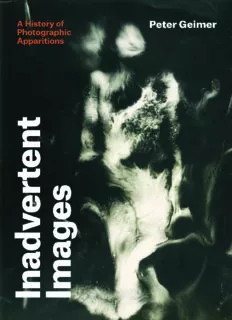
Inadvertent Images: A History of Photographic Apparitions PDF
Preview Inadvertent Images: A History of Photographic Apparitions
Inadvertent Images Inadvertent Images Peter Geimer A History of Photographic TranslaTed b y Apparitions GerriT Jackson The University of Chicago Press Chicago and London The University of Chicago Press, Chicago 60637 The University of Chicago Press, Ltd., London © 2018 by The University of Chicago All rights reserved. No part of this book may be used or reproduced in any manner whatsoever without written permission, except in the case of brief quotations in critical articles and reviews. For more information, contact the University of Chicago Press, 1427 East 60th Street, Chicago, IL 60637. Published 2018 Printed in the United States of America Originally published as Bilder aus Versehen: Eine Geschichte fotografischer Erscheinungen. © Philo Fine Arts Stiftung & Co. KG, Hamburg, Germany. 27 26 25 24 23 22 21 20 19 18 1 2 3 4 5 ISBN- 13: 978- 0- 226-4 7187- 7 (cloth) ISBN- 13: 978- 0- 226-4 7190-7 (e- book) DOI: 10.7208/chicago/9780226471907.001.0001 Library of Congress Cataloging-in-Publication Data Names: Geimer, Peter, author. | Jackson, Gerrit, translator. Title: Inadvertent images : a history of photographic apparitions / Peter Geimer ; translated by Gerrit Jackson. Other titles: Bilder aus Versehen. English Description: Chicago ; London : The University of Chicago Press, 2018. | Includes bibliographical references and index. Identifiers: LCCN 2017038031 | ISBN 9780226471877 (cloth : alk. paper) | ISBN 9780226471907 (e-book) Subjects: LCSH: Photography—Psychological aspects. | Photography—History. | Photography— Philosophy. | Phenomenology. Classification: LCC TR183 .G4513 2018 | DDC 770—dc23 LC record available at https://lccn.loc.gov/2017038031 ♾ This paper meets the requirements of ANSI/ NISO Z39.48- 1992 (Permanence of Paper). Contents Introduction 1 1 History and “Prehistory” 11 2 Visibility by Destruction/ Disturbance Incidents of Photography 31 3 Case Study I: Signs of Life or “False Flames”? Jules Luys and the Controversy over “Effluviography” 77 4 Case Study II: A Self- Portrait of Christ or the White Noise of Photography? Paul Vignon and the Earliest Photograph of the Shroud of Turin 99 5 Visible/Invisible Critique of a Dichotomy 140 6 The “Optical Unconscious” of Photography 170 Notes 201 Index 231 Introduction In 1929 the Hungarian photographer André Kertész took a picture of the Paris cityscape. The photograph shows a steeply descending street in the 18th arrondissement, with the spire of Notre Dame de Clignancourt behind it and a sea of houses stretching to the edge of the frame. The photograph was presumably meant to bear a title such as Paris or View of Paris. When the glass negative was subsequently shattered, Kertész gave his picture another title: Broken Plate (fig. 1). It shows Paris but also, simultaneously, the glass of which the photograph is made. An accident has made visible what usually disappears in the vitreous transparency of the photographic medium. So Broken Plate keeps the beholder’s gaze wavering indefinitely: between the picture of the city and the material of the picture, between the representa- tion and the web of cracks that disrupts it. In his phenomenology of the photograph, Roland Barthes describes pri- marily one side of this indissoluble figure—the transparency of the photo- graphic image. In this connection, he also brings up a picture by Kertész (fig. 2): “There is a photograph by Kertész (1921) which shows a blind gypsy violinist being led by a boy; now what I see, by means of this ‘thinking eye’ which makes me add something to the photograph, is the dirt road; its tex- ture gives me the certainty of being in Central Europe; I perceive the refer- ent (here, the photograph really transcends itself: is this not the sole proof of its art? To annihilate itself as medium, to be no longer a sign but the thing itself?).”1 As is well known, Barthes saw this art of disappearance as the essence of photography. In contradistinction to other pictorial techniques, photography succeeds in “annihilat[ing] itself as medium”; by simply show- ing “the thing itself,” it ultimately becomes invisible. “A specific photograph, in effect, is never distinguished from its referent (from what it represents), or at least it is not immediately or generally distinguished from its referent (as is the case for every other image, encumbered—from the start, and be- 2 IntroductIon Fig. 1 André Kertész, Broken Plate, 1929. © Estate of André Kertész/Higher Pictures. cause of its status—by the way in which the object is simulated): it is not im- possible to perceive the photographic signifier (certain professionals do so), but it requires a secondary action of knowledge or of reflection.”2 Barthes illustrates his utopian vision of the disappearance of the photographic sub- stance with a peculiar comparison: “The Photograph belongs to that class of laminated objects whose two leaves cannot be separated without destroy- ing them both: the windowpane and the landscape.”3 The old metaphor of the picture as a window on the world has been turned on its head: the pic- ture Barthes writes about is not manufactured by artifice but shows itself of its own accord, appearing like a landscape in the field of view demarcated by the window—without indirection, mediation, or the likelihood of diver- gence. We see through a photograph as we see through a glass pane. A pic- ture like the shot of the blind violinist who walked down a Hungarian village street decades ago, in this reading, allows our gaze to fall upon a moment in the past, but as the medium of such rendering-v isible, it is itself intangible. Fig. 2 André Kertész, Violinist, 1921. © Estate of André Kertész/Higher Pictures.
Description: